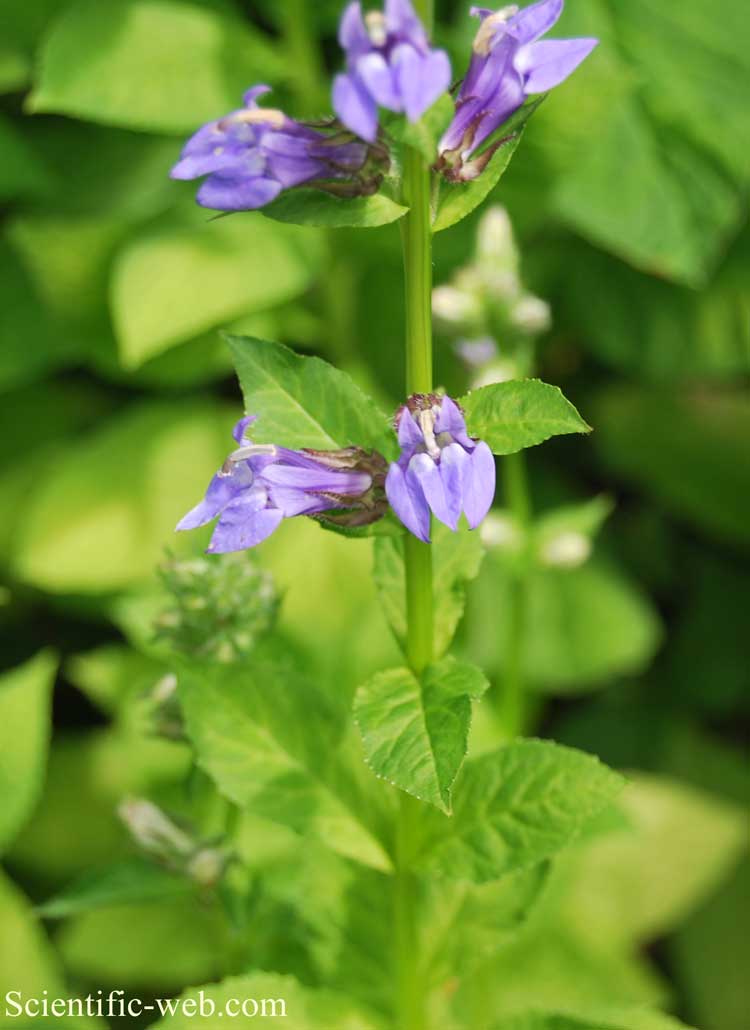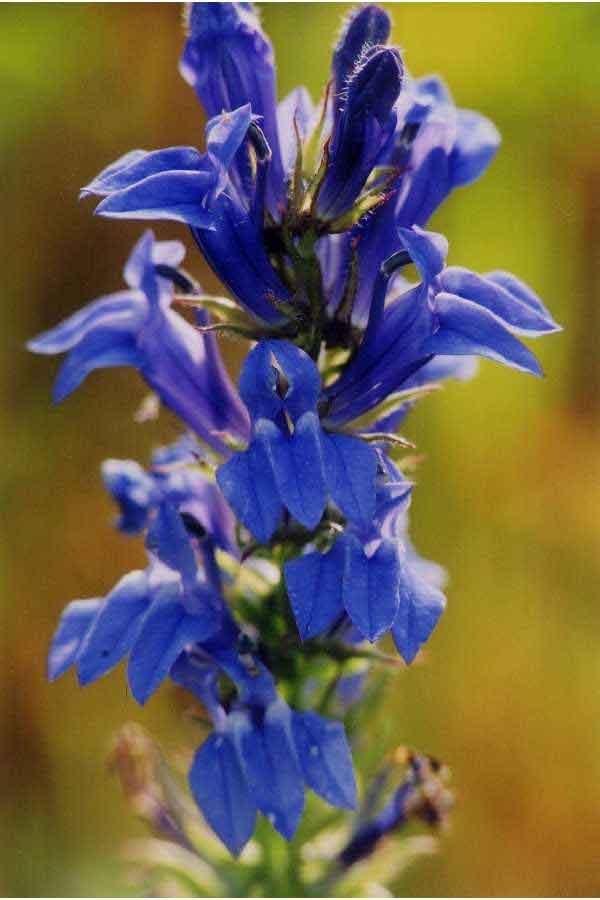
Lobelia siphilitica , Photo: Michael Lahanas
Classification System: APG IV
Superregnum: Eukaryota
Regnum: Plantae
Cladus: Angiosperms
Cladus: Eudicots
Cladus: Core eudicots
Cladus: Asterids
Cladus: Campanulids
Ordo: Asterales
Familia: Campanulaceae
Subfamilia: Lobelioideae
Genus: Lobelia
Species: Lobelia siphilitica
Name
Lobelia siphilitica L., Sp. Pl.: 931 (1753).
Synonyms
Homotypic
Rapuntium siphiliticum (L.) Mill., Gard. Dict. ed. 8: n.º 2 (1768).
Lobelia reflexa Stokes, Bot. Mat. Med. 1: 342 (1812), nom. superfl.
Lobelia antisyphilitica Hayne, Getreue Darstell. Gew. 13: t. 9 (1813), nom. superfl.
Dortmanna siphilitica (L.) Kuntze, Revis. Gen. Pl. 2: 380 (1891).
Heterotypic
Rapuntium syphiliticum Moench, Methodus: 655 (1794), orth. var.
Lobelia coelestis Nutt. ex Loudon in J.C.Loudon, Hort. Brit.: 592 (1830).
Lobelia densiflora Rennie, Mag. Bot. Gard. 1: t. 67 (1833).
Lobelia siphilitica var. minor Hook., Compan. Bot. Mag. 1: 100 (1835).
Lobelia siphilitica var. alba G.Don & W.H.Baxter in J.C.Loudon, Hort. Brit., ed. 3: 646 (1839).
Lobelia siphilitica var. ludoviciana A.DC. in A.P.de Candolle, Prodr. 7: 377 (1839).
Lobelia siphilitica var. maculata A.DC. in A.P.de Candolle, Prodr. 7: 377 (1839).
Lobelia belgica De Jonghe, Rev. Hort. (Paris), sér. 2, 4: 39 (1845).
Lobelia siphilitica var. rosea N.Coleman, Kent. Sci. Inst. Misc. Publ. 2: 24 (1874).
Lobelia siphilitica var. candida Alph.Wood, Class-book Bot.: 476 (1881).
Lobelia siphilitica f. albiflora Britton, Bull. Torrey Bot. Club 17: 125 (1890).
Lobelia siphilitica f. alba (G.Don & W.H.Baxter) Voss, Vilm. Blumengärtn. ed. 3, 1: 576 (1894).
Lobelia siphilitica f. ludoviciana (A.DC.) Voss, Vilm. Blumengärtn. ed. 3, 1: 576 (1894).
Lobelia siphilitica f. purpurea Voss, Vilm. Blumengärtn. ed. 3, 1: 576 (1894).
Lobelia bollii E.Wimm., Repert. Spec. Nov. Regni Veg. 26: 3 (1929).
Lobelia siphilitica f. laevicalyx Fernald, Rhodora 45: 476 (1943).
Lobelia siphilitica var. densiflora (Rennie) E.Wimm., Ann. Naturhist. Mus. Wien 56: 340 (1948).
Lobelia siphilitica var. bollii (E.Wimm.) E.Wimm. in H.G.A.Engler (ed.), Pflanzenr., IV, 276b: 423 (1953).
Lobelia siphilitica var. grandis E.Wimm. in H.G.A.Engler (ed.), Pflanzenr., IV, 276b: 422 (1953).
Lobelia siphilitica f. purpurea E.J.Palmer & Steyerm., Brittonia 10: 118 (1958), nom. illeg.
Distribution
Native distribution areas:
Northern America
Alabama; Arkansas; Austria; Colorado; Connecticut; Delaware; Georgia; Illinois; Indiana; Iowa; Kansas; Kentucky; Louisiana; Maine; Manitoba; Maryland; Masachusettes; Michigan; Minnesota; Mississippi; Missouri; Nebraska; New Hampshire; New Jersey; New York; North Carolina; North Dakota; Ohio; Oklahoma; Ontario; Pennsylvania; Rhode I.; South Carolina; South Dakota; Tennessee; Texas; Vermont; Virginia; West Virginia; Wisconsin; Wyoming

Lobelia siphilitica , Jennifer Anderson @ USDA-NRCS PLANTS Database
References: Brummitt, R.K. 2001. TDWG – World Geographical Scheme for Recording Plant Distributions, 2nd Edition
References
Linnaeus, C. 1753. Species Plantarum. Tomus II: 931. Reference page.
Links
Govaerts, R. et al. 2019. Lobelia siphilitica in World Checklist of Selected Plant Families. The Board of Trustees of the Royal Botanic Gardens, Kew. Published online. Accessed: 2019 Aug. 05. Reference page.
International Plant Names Index. 2019. Lobelia siphilitica. Published online. Accessed: Aug. 05 2019.
Tropicos.org 2019. Lobelia siphilitica. Missouri Botanical Garden. Published online. Accessed: 05 Aug. 2019.
USDA, ARS, Germplasm Resources Information Network. Lobelia siphilitica in the Germplasm Resources Information Network (GRIN), U.S. Department of Agriculture Agricultural Research Service. Accessed: 09-Oct-10.
Vernacular names
Deutsch: Blaue Kardinalsblume, Staudenlobelie, Virginische Lobelie
English: great blue lobelia
suomi: tähkälobelia
français: lobélie bleue
Nederlands: Virginische lobelia
русский: лобелия синяя, лобелия сифилитическая
中文: 大山梗菜
Lobelia siphilitica, the great blue lobelia,[2] great lobelia,[3] or blue cardinal flower,[4] is a plant species within the family Campanulaceae. It is an herbaceous perennial dicot native to eastern and central Canada and United States. There are two recognized varieties of Lobelia siphilitica, Var. siphilitica and Var. ludoviciana.[5] Blooming from August to October,[6] it is short-lived, lasting only for a few years.[6]
Although self-compatible, a flower is unable to offer pollen to itself and it must be pollinated by insects, primarily bumblebees.[6] Bees use the lower three fused petals as a landing pad. A bee of correct weight will depress these petals on its way to the flower's nectar, this lowers the stigma wiping it against the bee's back.[7]
Description
Morphology
Growing up to four feet tall, Great lobelia has a single ridged, unbranched stem, which is smooth or sparsely hairy. Leaves are hairless or scarcely hairy, that vary in shape from elliptical to lance-like, slightly narrowing at the base. They are about 2 inches wide and 2 to 6 inches in length. Leaves are alternately attached to the stem with no leaf stalk.[8] The root system is a central taproot, that occasionally produces basal offshoots.[5]
It produces a spike of zygomorphic flowers in the late summer. The flowers are more closely clustered towards the top of the raceme and become more infrequent further down with the lower flowers begin blooming first.[9] Great lobelia flowers are notably large than many other lobelia species. Flowers are typically blue or violet, but can be lighter, even white and are usually about 1 in long.[10] The tubed portion of the flower is often striped. Great lobelia flowers have 5 petals; the 3 lower petals are fused, and the 2 upper petals are usually curled back. A curved style pokes between the upper two petals. The lower center lobe is wider and has 2 small bumps near the throat that are typically lighter in coloration.[5] Seed pods are two-chambered with an auriculate base and have many small seeds. Seeds are ovular, translucent, and golden brown and are presumed to be distributed by wind or water.[11]
Distribution and Habitat
Great lobelia is found in the north from Maine to Manitoba and in the south from North Carolina to Texas. Sparse populations can be found as far west as Wyoming and Colorado.[12]
It thrives in moist to wet soils and partially shaded environments, including swamp forests, roadside ditches, floodplains, lake margins, and wet prairies.[12]
Cultivation
Lobelia siphilitica is sold in garden centers and is often grown in zones 4 to 9. It can be propagated either by cutting or seed.[12]
Uses
Native Americans used this species to treat respiratory and muscle disorders. It was once considered a cure for syphilis by early European settlers, which is where the scientific name for this species originates.[12]
References
Maiz-Tome, L. (2016). "Lobelia siphilitica". IUCN Red List of Threatened Species. 2016: e.T64317288A67729987. doi:10.2305/IUCN.UK.2016-1.RLTS.T64317288A67729987.en. Retrieved 12 November 2021.
USDA, NRCS (n.d.). "Lobelia siphilitica". The PLANTS Database (plants.usda.gov). Greensboro, North Carolina: National Plant Data Team. Retrieved 26 January 2016.
BSBI List 2007 (xls). Botanical Society of Britain and Ireland. Archived from the original (xls) on 2015-06-26. Retrieved 2014-10-17.
"Lobelia siphilitica". Missouri Botanical Garden. Retrieved 2020-08-19.
"Lobelia siphilitica (Blue Lobelia): Minnesota Wildflowers". www.minnesotawildflowers.info. Retrieved 2021-12-23.
Caruso, C. M. (2006), "Plasticity of inflorescence traits in Lobelia siphilitica (Lobeliaceae) in response to soil water availability", American Journal of Botany, 93 (4): 531–8, doi:10.3732/ajb.93.4.531, PMID 21646213
"Great Blue Lobelia". www.fs.fed.us. Retrieved 2021-12-23.
"Lobelia siphilitica (Blue Lobelia): Minnesota Wildflowers". www.minnesotawildflowers.info. Retrieved 2021-12-23.
"Lobelia siphilitica (Blue Lobelia): Minnesota Wildflowers". www.minnesotawildflowers.info. Retrieved 2021-12-23.
"Great Blue Lobelia". www.fs.fed.us. Retrieved 2021-12-23.
"USDA Plants Database". plants.usda.gov. Retrieved 2021-12-23.
"USDA Plants Database Lobelia siphilitica Plant Guide". plants.usda.gov. Retrieved 2021-12-23.
Retrieved from "http://en.wikipedia.org/"
All text is available under the terms of the GNU Free Documentation License

